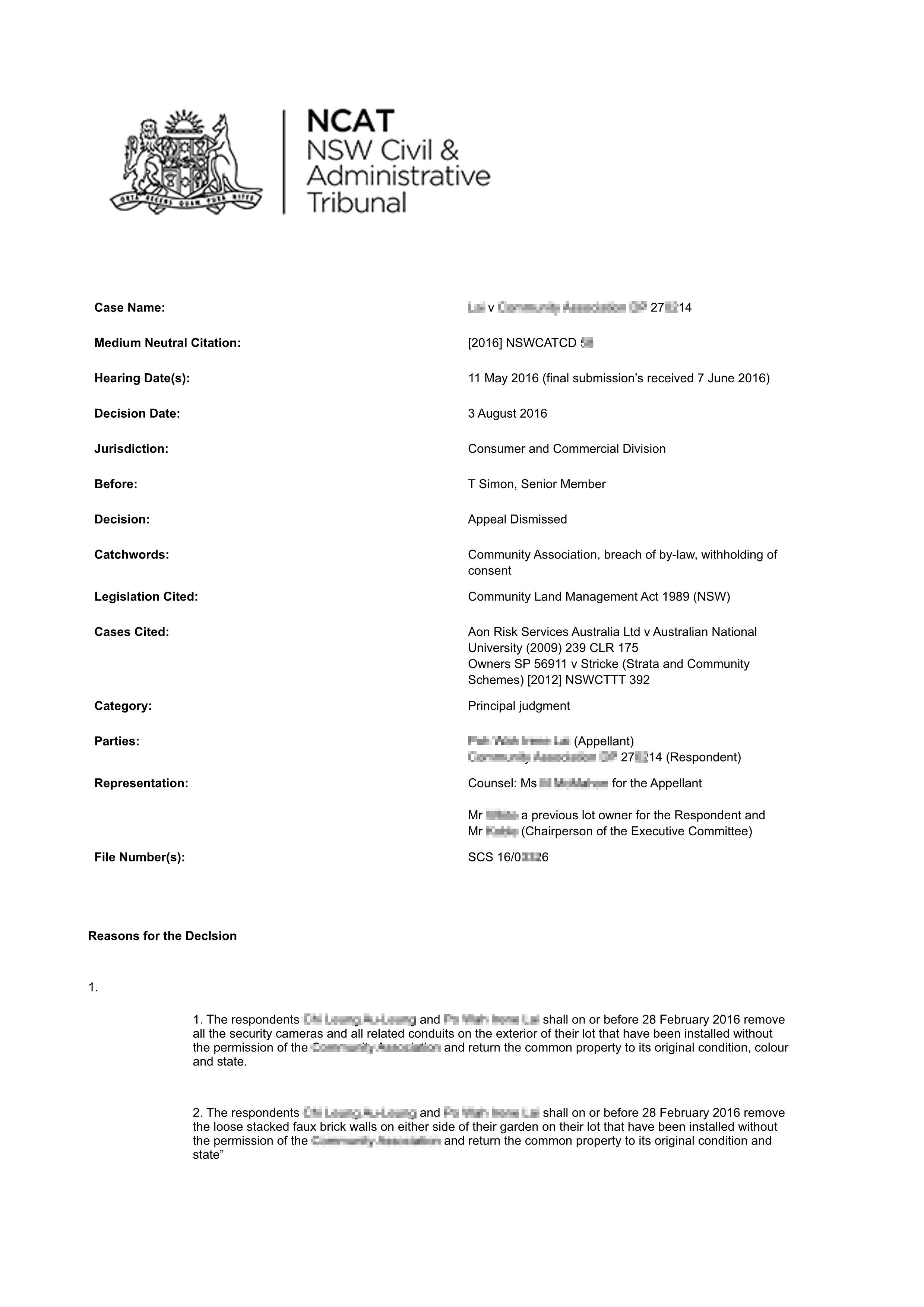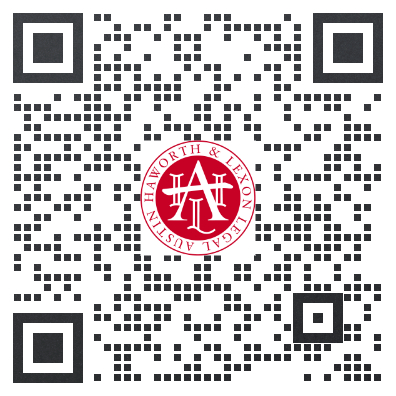【Classic Cases】LXX v Community Association DP 27XX14 [2016] NSWCATCD XX

REASONS FOR THE DECISION
The application was lodged with the Registry on 20 January 2016 and is an appeal of an Adjudicator’s decision made on 2 December 2015. The following orders were made against the Appellant:
1. The respondents ChX LeXXg AX-LeXXg and PX WXX IrXXe LXX shall on or before 28 February 2016 remove all the security cameras and all related conduits on the exterior of their lot that have been installed without the permission of the Community Association and return the common property to its original condition, colour and state.
2. The respondents ChX LeXXg AX-LeXXg and PX WXX IrXXe LXX shall on or before 28 February 2016 remove the loose stacked faux brick walls on either side of their garden on their lot that have been installed without the permission of the Community Association and return the common property to its original condition and state”
The Appellant is seeking the following orders:
(1) The appeal is upheld;
(2) The order made by the adjudicator on 2 December on file number SCS 15/54XX0 be revoked;
(3) The application for adjudication SCS 15/54XX0, lodged on 23 September 2015, be dismissed immediately.
The application for adjudication was made by the Community Association seeking orders that the Appellant remove a security camera and all related conduits and loose stacked faux brick walls on either side of their garden. The Community Association alleged that the items had been installed on the lot by the lot owner in breach of the by-laws and without approval from the Community Association. The Respondent had also sought an order that the Appellant return the common property to its original state. The initial adjudication had also been seeking an order that the lot owner remove the security screens across the fixed glass panels. The Adjudicator found that consent had been obtained for installation of those screens and they are not an issue in this appeal.
The Tribunal is of the view that this is a hearing de-novo and adopts the reasoning articulated in Owners SP 56911 v Stricke (Strata and Community Schemes) [2012] NSWCTTT 392 which concluded:
47. The provisions of sections 181 and 186 of the Act are, in my opinion, such as to demonstrate that an appeal from an Adjudicator's decision is by way of a hearing de novo. On that basis, the Tribunal is not required to first demonstrate error on the part of the Adjudicator, is required to exercise its own jurisdiction in relation to the appeal and therefore may consider fresh evidence - indeed, it follows in my view that where the factual situation has changed or better evidence becomes available, whether or not such evidence was available to the adjudicator, the Tribunal would be required to allow that fresh evidence in order to give proper consideration to the issues.
In that regard directions were made by the Tribunal on 10 February 2016 for the parties to exchange documents. The Tribunal received the following:
(1) Submissions and documents from the Appellant on 11 March 2016.
(2) Submissions and documents from the Respondent on 6 April 2016.
(3) A further statement with attachments from the Appellant on 5 May 2016.
(4) A statement from Ms PaXXXcia WhXXX for the Respondent on 9 May 2016. That statement was provided outside the directions of the Tribunal and the Respondent sought leave for the Tribunal to allow the statement. The Appellant objected on the basis that the statement was prejudicial in that it was signed but not sworn and on the basis that Ms WhXXX was not available for cross examination in relation to the statement. Consideration of the statement was allowed subject to weight.
(5) The Appellant’s submission’s in reply on 9 May 2016.
(6) Submissions in relation to the issue of the appeal being made within time were provided by the Appellant on 13 May 2016.
(7) Submissions and a bundle of documents were received from the Respondent on 27 May 2016. They contain material beyond simply addressing the issue of the appeal being made out of time and go to the substance of the appeal itself. The Appellant wrote to the Tribunal on 7 June 2016 objecting to those further submission’s and documents being relied on. Consistent with the principals in Aon Risk Services Australia Ltd v Australian National University [2009] HCA 27; (2009) 239 CLR 175, the Tribunal has only considered those documents and submissions in so far as they related to whether the appeal was made within time.
Otherwise, the Tribunal confirmed that each party had received the other party's documents and had been given an opportunity to view them. Accordingly, all those documents received by the Tribunal from the parties have been considered in coming to this decision.
Jurisdiction
Pursuant to section 88 of the Community Land Management Act 1989 (NSW) the applicant is entitled to appeal the decision of the Adjudicator.
(i) not later than 21 days after the order takes effect, or
(ii) by leave of the Tribunal (given on sufficient cause being shown why the notice was not lodged within the time limited by paragraph (a))-not later than 90 days after the order takes effect.
The notice of the orders is dated 1 December 2015 and the Registry had stamped that the appeal was lodged on 20 January 2015.
The matter was not addressed at the hearing and after the hearing the Tribunal called for submission’s on the matter. It appears from the Tribunal records reveal that the application was incorrectly stamped and that the appeal was actually lodged with the Tribunal on 22 December 2015 making the appeal within time.
Accordingly, The Tribunal is satisfied that had jurisdiction to decide the matter.
The Appellants Case
In relation to the faux brick wall, the Appellant makes submission’s that in coming to his decision the Adjudicator failed to take in consideration the construction of by-law 12 and that the Adjudicator held that approval was needed before any work was carried out without giving proper regard to the by-laws construction.
They contend that a proper construction of by-law 12 makes it clear that approval is only required if a lot owner or occupier constructs, installs or maintains anything, which can be seen from outside of the lot and which in the reasonable opinions of the Community Association is not in keeping with the building or the landscaped areas of the lot.
Further, they made submission’s that communication with the Appellant’s pervious solicitors, ChXX Legal and the Respondent demonstrate that the Appellant through her solicitor was in communication with the Respondent about the items in dispute 3 years ago and that contrary to the findings by the Adjudicator, the Appellant had sought approval for the two remaining items in dispute.
They refer to the Respondent’s submissions at page 5 which detail how they in fact gave permission for the brick walls to remain in place, notwithstanding that they believed them to be not in keeping, were not approved and deemed a breach of bylaw 12. The Appellant makes submission’s that for the Respondent to then bring a case stating that no such approval was sought for the item was vexatious and mischievous in the circumstances.
In relation to the security cameras the Appellant make submission’s that the Adjudicator failed to take in to account the submissions that were made by the Appellant that they were in place for 7 years before any complaint was made and by-law 11 and the architectural standards.
They also stated that in 2007, the Appellant advised the Community Association about attempted burglaries sought to have more security around her home. In 2013, the Appellant stated that she started having trouble from their neighbours at number 20 which such as garden plants being cut, grass poisoned, eggs being thrown and having fertilizer thrown on them and that those incidents were reported to police and verbally to the Community Association by the Appellant.
They refer to by-law 11 only requires that the security cameras must not be installed in a place that is obtrusive from the outside of the lot and that there is no apparent breach of architectural standards and therefore the community association was not to unreasonably withhold consent for their installation pursuant to by-law 10.2.
They refer to the statement of Ms LXX which attaches email correspondence between her solicitor and Mr WoXXdy on behalf of the Respondent in respect to a complaint by the Appellant’s neighbour about the direction of the cameras. They contend that if no approval existed for their installation than the Appellant would have been asked to remove them and no such request or demand was made.
Ms LXX also stated that PaXXXcia WriXXX, the secretary of the Respondent was well aware of the cameras and stated that she was happy for them to remain. Ms LXX states that approval was sought informally and given informally.
In her statement, Ms LXX states that she sought permission prior to installation of cameras in late 2008/early 2009. It is her evidence that she was told she could install them. Based on that representation, she went ahead and paid for their installation.
The Appellant states that given the uncontested evidence that a security camera was in place upon purchase of her home and that additional cameras have been installed, Ms LXX's account of the informal approval must be accepted.
In that regard the Appellant relied on the common law principles of election and estoppel a preventing the Respondent from seeking any order now being made to remove the cameras.
The Respondents Case
In relation to the security cameras the Respondent relied on their original submissions in the adjudication and in particular a letter from Civium, the Community Association's Managing Agents stating that remedial action was required and the Community Association's request for compliance consistent with by-laws 10.1and 12.
They state that there is no evidence that approval had been obtained for the security cameras to be installed.
They allege the Appellant has not followed due process regarding the by-laws by making multiple applications to the Community Association in writing directly through her legal representatives AHL Legal .
In relation to the faux brick walls the Respondent makes submissions that the faux bricks loosely stacked are a wall and that it is a construction that requires approval from the Community Association to be lodged by the Appellant’s. They make submissions that no approval has been sought by the Appellant.
They also state that after correspondence from the Appellant’s solicitors was received that on 12 November 2013, at a meeting of the executive of the Community Association a discussion occurred about the wall and it was resolved that the walls did not comply with by-law 12 but that the removal would not be requested at that stage. On 18 November 2013, following that meeting the Community Association secretary wrote to the Appellant saying:-
I am writing in regard to your email dated 8 October 2013. Among other things in that communication; you mentioned the recently installed blocks along the side boundaries of your client's property at XX Kendall Inlet.
By Law 12 of the Kendall Inlet Community Management Statement says:
"The proprietor or occupier of a Lot must not, except with the approval of the Community Association, construct, install or maintain anything on or in a Lot, which can be seen from outside the Lot, and in the reasonable opinion of the Community Association, is not in keeping with the building or the landscape features of the Lot."
The fences that divide XX Kendall Inlet from XX and XX Kendall Inlet are white powder coated metal "picket" style fences, as is the fence separating the property from the waterfront area.
It is the opinion of KXXA that the installation and maintenance of the besser blocks that form fence like barriers are not in keeping with the building and the landscape features of the Lot, do not comply with By Law 12 of the Kendall Inlet Community Management Statement, and are therefore not approved.
However, at this point in time, KXXA is not seeking their removal. Please advise M s LXX accordingly.
Yours sincerely, PaXXXcia WriXXX Secretary, KXXA
The Respondent also refer to the Adjudicators reasons in which he stated:
19. I am persuaded to make the orders sought for the removal of the unauthorised items. In making this order I will allow sufficient time for the respondents to carry out the order or to follow the correct process and retrospectively seek the proper approval for the items to remain from the Community Association"
The Respondent’s make submissions that an opportunity had been given to the Respondent to seek retrospective approval from the Community Association before 28 February 2016 and that they have not done so.
Consideration and Decision
Faux Brick Wall
By-law 12 relates to things not in keeping and states the following:
The proprietor or occupier of a Lot must not, except with the approval of the Community Association, construct, install or maintain on or in a Lot anything which can be seen from outside the Lot and which in the reasonable opinion of the Community Association is not in keeping with the building or the landscaped areas of the lot.
While not well-expressed the Tribunal finds that a proper construction of by-law 12 requires that:
(i) Consent must be obtained from the Community Association for anything which is constructed, installed or maintained on a lot and can be seen from the outside and;
(ii) If consent is required, the item constructed, installed or maintained must be in the reasonable opinion of the Community Association in keeping with the building and landscaped areas of the lot.
Dealing with the first point the applicant has made submissions that the photographs they have provided show that the wall is “barely visible” from the outside lot. However a photograph provided with submissions of the Respondent on 6 April 2016 and which was provided in the initial adjudication and taken outside of the Appellant’s fence, shows that the wall is visible and in that regard the Tribunal is satisfied that the Appellant has constructed a wall (even if it is by way of stacking) on the lot which can be seen from outside the lot.
In that regard the Tribunal is satisfied that consent is required from the Community Association in relation to the construction of the wall. The Respondent relies on the fact that the correspondence does not amount to consent. In particular the correspondence of the 18 November 2013 from the Community Association secretary states that at that point in time (emphasis added) the Community Association was not seeking removal of the wall. That does not amount to consent, and does not mean that action could not be taken at a later time. Read in its entirety that correspondence does not amount to consent for the wall from the Community Association. The correspondence clearly refers to the wall being a breach of by-law 12.
Moreover, it is clear from that correspondence that the Community Association had considered whether to grant consent to the wall and had decided that the sandstone (or besser blocks as they referred to them) forming the wall was not in keeping with the building and the landscape features of the lot. In particular they referred to the fact that the fences dividing the lots and separating the properties from the waterfront were “white powder coated metal "picket" style fences”. Having considered the photographs the Tribunal does not find that opinion was an unreasonable opinion for the Community Association to hold.
Further, the fact that Respondent has delayed in taking action in relation to the wall does not mean they have waived their rights to take action in relation to wall. The correspondence of 18 November 2013 simply stated that they were not taking action at that point in time.
Likewise, the issues described by the Appellant about disputes with her neighbours and the need for the wall so as to prevent them, is not relevant to the consideration of whether the wall is in keeping with the landscaped lot. The Appellant may have other remedies in relation to any breaches by neighbouring lot owners.
Having considered the evidence of the parties in its entirety the Tribunal finds that the wall is visible from outside the lot and that consent was required to be obtained by the Appellant from the Community Association for the construction of the wall and that such consent was sought and has not been unreasonably withheld from the Community Association.
Security Cameras
By-law 10.1 and 10.2 of the by-laws relate to the fixing of shutters, blinds, security devices and fly screens and relevantly state:
10.1 The proprietor or occupier of a Lot must not, except with the approval of the Community Association:
....
(b) fix bars, screens, security doors or other security devices to the outside of a building on a Lot or the outside of a building containing a Lot....
10.2 The approval of the Community Association may not be withheld unreasonably where the items to be fixed comply with the Architectural Standards established for a lot in relation to the items.
The Tribunal finds that the cameras are security devices. Having considered the photographs it is also apparent that the cameras are visible from outside the lot and as such approval was required from the Community Association for their installation.
Ms LXX gave evidence that she had informally sought approval for the cameras and that it had been given it by the Respondent. In particular, in her statement of 4 May 2016, Ms LXX stated that after attempted burglaries on 26 September 2007 and from 20-21 December 2008 she spoke with another lot owner “JXX” whose husband AlXX was part of the Community Association and asked her about installing the cameras. She stated JXX had spoken at her husband who had raised it at a meeting and that JXX had told her that it was fine and she did not need to put in an application. She also refers to a conversation with Ms PaXXXcia WriXXX who was the then secretary. She stated that MS WriXXX told her that another neighbour had complained that the cameras were breaching her privacy. She stated that after asking if she would get into trouble Mr WriXXX replied:
“Don’t worry, we will not do anything. We don’t care about the cameras, let her complain.”
Having considered the evidence in its entirety on this point the Tribunal does not find that the conversation with JXX or Ms WriXXX amount to consent from the actual Community Association, including the conversation that she had with Ms WriXXX who was a secretary of the Community Association. Any conversations that the Appellant may have had with individuals who are on the Executive Committee do not necessarily amount to consent by Community Association. In any case even if the statement was taken to be on behalf of the Community Association, it does not provide consent, rather states that no action will be taken. In that regard the Tribunal does not find that in its context that statement can be read to infer that Ms WriXXX was indicating on behalf of the Community Association that the Community Association had consented to the camera’s, rather, at its highest that the Community Association would not doing anything further about the complaint.
Further, it does not appear that approval has ever been formally sought by the Appellant for the cameras or that consent has been formally denied by the Respondent on any basis. In those circumstances the Tribunal cannot find that consent has been considered and unreasonably withheld by the Respondent.
Accordingly, the appeal fails and the orders made by the Adjudicator remain in force.
T Simon
Senior Member
Civil and Administrative Tribunal of New South Wales
3 August 2016
I hereby certify that this is a true and accurate record of the reasons for decision of the Civil and Administrative Tribunal of New South Wales.
Registrar



 1300 91 66 77
1300 91 66 77







 HOME
HOME


